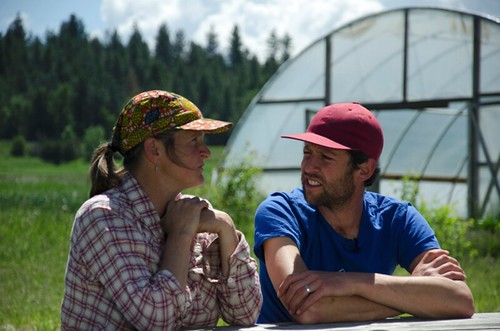
When I learned that the “This American Land” public television series was headed to Montana, I knew this would be a great opportunity to highlight organic producers and the work USDA’s Natural Resources Conservation Service (NRCS) is doing to increase conservation across the state. I’ve been working for NRCS for 10 years and in the Ronan, Montana, field office since 2010. Since transferring to Ronan, I’ve devoted much of my time to providing technical and financial assistance to beginning farmers in the area – especially landowners who are engaged or interested in diversified organic vegetable production for local markets.
Building lasting relationships goes hand-in-hand with getting conservation on the ground. So, when Ben Ferencz and Julie Pavlock of Foothills Farm in St. Ignatius were interested in expanding their farm, they reached out to me about available NRCS programs.
First things first: we developed a conservation plan – a road map of how we are going to reach our conservation goals. The plan included:
- Transitioning all their fields to certified organic,
- Adding cover crops for soil health to their vegetable production rotations,
- Installing a high tunnel, or “hoop house,” with automated drip irrigation,
- Planting hundreds of trees and shrubs to increase beneficial insect and pollinator habitat, and
- Beginning a soil sampling and nutrient management program to best meet their crop needs and protect the environment.
Once we wrote the plan, Ferencz and Pavlock needed help implementing their conservation practices. Soon after, they applied for and were accepted into NRCS’ Environmental Quality Incentives Program (EQIP) Organic Initiative. This program’s financial and technical assistance helps producers plan and implement conservation practices – such as establishing buffer zones, planning and installing pollinator and beneficial insect habitat, improving soil quality and organic matter while minimizing erosion – to support the environmental sustainability of their organic operations.
They have completed their first contract and are starting a second contract to further their conservation efforts. While the first plan focused on their vegetable production, the second plan deals with their livestock operation.
Foothills Farm now has a prescribed grazing plan from NRCS, and they are moving their cattle every two or three days between paddocks with temporary electric fencing. They are allowing each paddock to rest for at least 30 days. Their goal is to increase productivity from the soil on up, which should improve animal performance and reduce the need for winter hay feeding.
While Foothills Farm is a great example of the work NRCS is doing with organic farmers, there are many Montana landowners and field offices working together to conserve our nation's precious natural resources.
For example, Bob Nansel who was also featured on “This American Land” works with organic producers in his area. Nansel is the NRCS district conservationist in the Fort Benton/Big Sandy field office. He has worked with Andrew Long, who runs an on-farm oil crushing facility near Big Sandy, Montana, called The Oil Barn. The Quinn Organic Farm and Research Center, owned and operated by Andrew’s wife’s family, grows organic crops, including safflowers. Long crushes the safflower from Quinn’s, and his other oilseed suppliers, to extract the oil, and the oil is then sold to restaurants. In turn, The Oil Barn receives the waste oil from the restaurants and the farm uses the waste oil as fuel.
These are just a few examples of NRCS technical and financial assistance meeting the needs of all farmers and ranchers, whether they are small and just starting out or large with established roots in the state. Either way, NRCS is 'helping people, help the land'.
View the “This American Land” video on organic producers in Montana here: https://www.youtube.com/watch?v=RuEyb5s_C3k&feature=youtu.be
